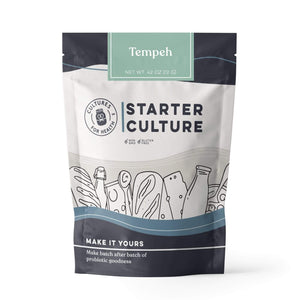
Add something different to your tempeh by combining the traditional soybeans with some nutritious grains.
20 minutes
180 minutes
4
INGREDIENTS AND EQUIPMENT AVAILABLE AT CULTURES FOR HEALTH
Tempeh Starter Culture

Tempeh Starter Culture
$14.99
Tempeh starter will help you create traditional tempeh, a plant-based probiotic protein, usually made from soy. It is similar to tofu, but many people prefer tempeh due to its probiotics and higher content of protein, fiber and vitamins.
It is a great meat alternativeand can be sliced, marinated, or seasoned as desired.
With our tempeh starter culture spores,you can make a supply of rich, nutty tempeh in the traditional Indonesian way!
INGREDIENTS:
- 1 cup hulled soy beans, soaked 10 to 12 hours
- 1/2 cup brown rice, soaked 6 to 8 hours
- 1/2 cup hulled millet, soaked 6 to 8 hours
- 2 Tbsp. rice vinegar
- 1 packet Tempeh Starter Culture
- 1 gallon plastic zip-top bag with holes punctured throughout, or 1 banana leaf
INSTRUCTIONS:
- Cook beans until just tender. Drain well. In a separate pan, cover grains with water and bring to a boil. Immediately turn off heat, rinse and drain.
- Mix together the grains and soy beans. Dry with a towel or blow dryer. They need to be a bit moist, but there should be no water in the bottom of the mixing bowl.
- Add the vinegar and sprinkle the tempeh starter over the bean and grain mixture. Stir thoroughly with a wooden or plastic spoon.
- If you are using a plastic bag, prepare it by punching holes with a needle at 1/2-inch intervals.
- Spoon the tempeh mixture into the prepared bags or leaves, secure, and flatten to the shape desired.
- Incubate the beans at 88°F for 24 to 48 hours.
- Check the beans after 12 hours. At this point in the process the fermentation will cause the beans to generate their own heat so you will normally need to reduce or even eliminate the external heat source. Be sure to use a thermometer to check the actual temperature (see below).
- After 24 hours or so, the white mycelium will start to cover the surface of the beans. Over the next few hours the white mycelium will grow through the beans and will smell nutty.
- After 24 to 48 hours, when the beans have become a single mass held together by the white mycelia, the tempeh can be refrigerated.
See our recipe for traditional tempeh for tips on preparing soybeans and incubating the tempeh.
















